-
The action of irrupting or breaking into; a violent entry or invasion; an intrusion.
-
An abrupt increase of numbers of a particular animal.
Learn something new every day.
The action of irrupting or breaking into; a violent entry or invasion; an intrusion.
An abrupt increase of numbers of a particular animal.
Learn something new every day.
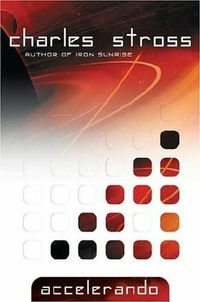 If Charles Stross’ goal with Accelerando was to explode the reader’s head, he succeeded with this customer. I’m not sure that’s a good thing though.
If Charles Stross’ goal with Accelerando was to explode the reader’s head, he succeeded with this customer. I’m not sure that’s a good thing though.
First off, Accelerando is built out of nine short stories. This is not made obvious within the paperback edition (or I missed it in the cover notes, intro, etc.) so it doesn’t quite read like a complete novel. For the first couple of chapters, the temporal leaps between tales are disorienting. And since these are nine distinct stories, while there are common elements, there’s not really a unifying plot.
The [nine stories](http://en.wikipedia.org/wiki/Accelerando_(book)) break down into three segments of three, chronicling characters from three generations of the Macx family: Manfred, his daughter Amber, and her son Sirhan. Events in Accelerando start from Manfred’s near future world, similar to ours where the onset of The Singularity is beginning. Amber lives in a post-Singularity, but still human oriented milieu. However, post-AI entities are starting to compete with humanity for domination of the solar system. Finally, Sirhan emerges in a world where planetary matter is being turned into “computronium” and humans are being banished from their home planets. Lesser beings and species are suffered existence as long as they stay out of the super-intelligence’s communication lines. This apparently is the natural order of the universe.
Stross’ attempts to stuff every sentence with a reference or nod to some aspect of singularity based Nerd Rapture. The flux of advanced concepts quickly becomes overwhelming. If the goal is to illustrate how a rapidly accelerating pace of technical advancement would feel to a lesser being, consider Accelerando a success. However, an accessible, completely coherent literary work this is not. The book is not without its charms, and is elegantly playful in spots, but it takes a lot of work on the reader’s behalf.
I’m sort of on the fence about Accelerando. On the one hand, I think it’s good enough that people I respect would get something out of reading the book. On the other hand, I wouldn’t go out of my way to recommend Accelerando to them. If you’re a Stross completist, or into hard Singularity science fiction, then this is your book.
For more on Stross in general, check out this “Charles Stross book event”, hosted by Crooked Timber. A number of luminaries, e.g. Paul Krugman, comment on various of Stross’ work, although there are some notable omissions, like The Atrocity Archives.
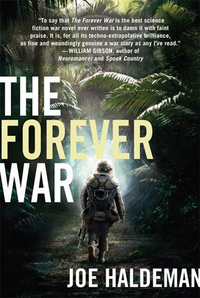 John Scalzi reports that Joe Haldeman’s The Forever War is being reissued. This is great, I’ve been looking to read The Forever War for a while. For whatever reason, Amazon only had old copies at outrageous prices through 3rd party sellers. My local library didn’t even have a copy.
John Scalzi reports that Joe Haldeman’s The Forever War is being reissued. This is great, I’ve been looking to read The Forever War for a while. For whatever reason, Amazon only had old copies at outrageous prices through 3rd party sellers. My local library didn’t even have a copy.
Now I can get my hands on a must read classic. We’ll see how well time has treated it.
The way Movable Type handles Markdown formatting on posts with body and extended parts. The Markdown from the body part doesn’t carry over to the extended part.
How MarsEdit doesn’t do well with re-editing of posts. I too often wind up with extra copies on the server.
How the [MarsEdit]((http://www.red-sweater.com/marsedit/) post preview window doesn’t display the destination of HTML links. Many of my posting errors involve incorrect links that could have easily been caught before posting.
 Without too much effort I managed to make it through January (and a bit of December) without an alcoholic beverage. No, I didn’t have a drinking problem. Occasionally I challenge myself with habit building exercises. This started off as a half whim and then I just kept rolling with it. Sort of like Jerry Seinfeld’s streak lifehack.
Without too much effort I managed to make it through January (and a bit of December) without an alcoholic beverage. No, I didn’t have a drinking problem. Occasionally I challenge myself with habit building exercises. This started off as a half whim and then I just kept rolling with it. Sort of like Jerry Seinfeld’s streak lifehack.
While surprisingly easy and pointless, it was also oddly satisfying. With the holidays and my wife’s penchant for social activities, there were plenty of opportunities to end the little experiment. Somehow I managed to wriggle off the hook each time.
I’m probably going to bust the streak later this week, as I meet up with an old drinking buddy for the first time in over a decade. We’ll probably tip back a beer or two.
Just wanted to log the achievement.
Photo courtesy of Flickr user jk5854. Used according to a Creative Commons By-NC License.
Apparently Chris Moriarty, the author of the excellent Spin Control, started a blog. Looks like its gone dark, but I didn’t know that Spin Control had won the 2006 Philip K. Dick award.
At least I know I have some SF taste. And the list of past winners is probably a good seed for feature reading.
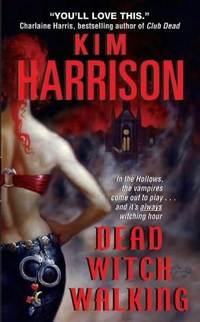 This review will be pretty straightforward. I could not stand Kim Harrison’s Dead Witch Walking.
This review will be pretty straightforward. I could not stand Kim Harrison’s Dead Witch Walking.
Dead Witch Walking is rightfully categorized as “urban fantasy.” Unfortunately that label applies to two wildly different strains of storytelling.
On the one hand, you have writers like Kim Harrison, Laurell K. Hamilton, and Patricia Briggs. You might call these authors descendants of Anne Rice, blending the supernatural, horror, and romance.
On the other hand, you’ve got Neil Gaiman, Cory Doctorow (at least for Someone Comes to Town, Someone Leaves Town), and Emma Bull. The intersection of the urban and the fantastic is the central focus. The romance is secondary or non-existent.
I’m a fan of the latter camp. Trying to extend my canon, I foraged on Amazon, came up with Dead Witch Walking, and wound up in the former camp. I did not enjoy the experience.
Rachel Morgan, the heroine of the story, is a supernatural bounty hunter. She practices her trade in Cincinnati, Ohio. A fictional area known as “The Hollows”, just across the river from Cincinnati, houses various fantastic sorts such as vampires, pixies, and demons. At the start of Dead Witch Walking, Morgan works for a big, soul sucking, bureaucratic organization. In the process of quitting and starting her independent agency, she becomes a marked woman. Solving the mystery of who’s after her and why takes up the bulk of the book.
In regards to the writing, I had two major beefs with Dead Witch Walking. First, there are a number of points where sexual tension is built up, but not resolved. I don’t need a tell all porn show, but no satisfaction is just irritating. Even the resolution of the main mystery left me wanting. Second, the world of The Hollows just didn’t project a satisfying, internal consistency. Maybe I need to be better educated about the mythos that Harrison was leveraging, but there were many elements of the fantastical milieu that left me going, “Hunh? Why?”
In the end, I don’t want to disparage Harrison’s abilities as an author. Clearly, she resonates with many people she is making quite happy. As for me, Dead Witch Walking was easily my worst read of 2008. Just not my cup of tea.
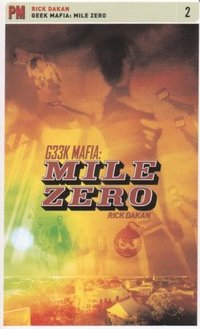 Rick Dakan’s Geek Mafia: Mile Zero fell a little flat for me. While I wasn’t particularly high on the first Geek Mafia, it was passable. The sequel really lost what little geekiness there was in the original. The result was a tedious game of keeping track of a number of confidence schemes, played out by a cast of fairly thin grifter characters.
Rick Dakan’s Geek Mafia: Mile Zero fell a little flat for me. While I wasn’t particularly high on the first Geek Mafia, it was passable. The sequel really lost what little geekiness there was in the original. The result was a tedious game of keeping track of a number of confidence schemes, played out by a cast of fairly thin grifter characters.
Paul, Chloe, and Bee, the remnants of a Crew formerly based out of Silicon Valley have moved to Key West, Florida. There they’re trying to reestablish themselves as a profitable con artist collective. Obviously, the different setting requires different tactics, and the reduced population makes the overall upside, and fun, a lot smaller. This aspect of their relocation seems to be chafing Paul and Chloe’s romantic relationship.
Enter Winston, Chloe’s mentor in The Life of Crews, who shows up unannounced in Key West. At Winston’s urging, a number of other leaders of large national/international crews are about to descend upon the adult playground. Plans to take The Life to the next level are brewing.
Things really get ignited after a murder takes place, throwing negotiations amongst the various leaders out of whack. Various double crosses and treacheries take place, as Paul and Chloe take up the task of solving the mystery. They also have to address the bigger picture of their fragile relationship and what role they might have if these big schemes actually hatch. Plus old ghosts from Silicon Valley rear their ugly head.
Too bad Geek Mafia: Mile Zero didn’t live up to the setup.
My first beef with Geek Mafia: Mile Zero is the lack of real exciting geekiness. Dakan doesn’t push into sci-fi by inventing new technology. Nor is there any creative extrapolation of present or near term capabilities. The tech used to pull of their scams seems pretty pedestrian to me. An average episode of Mission Impossible (TV or movie, take your pick) is more exciting in this aspect.
Secondly, after Paul and Chloe, the characters become fairly uninteresting and indistinguishable. You never really get much backstory on any of them , there’s way too many, and the plot doesn’t really allow anyone to stand out.
Finally, the plot? Well, let’s just say it’s a bit convoluted. To no good end.
I bought Geek Mafia: Mile Zero on the good graces of Geek Mafia. You won’t hurt yourself reading Geek Mafia: Mile Zero, but you’ve probably got better things you could be doing with your time.
Aaron Swartz knocked out exactly 100.
Matt Biddulph beat that book total by 4.
I did a measly old 30. According to the National Endowment for the Arts, I’m way ahead of at least 43% of adult Americans. I’d be willing to up that quite a bit since a book per 2 weeks is a solid if not spectacular clip. I haven’t read the report closely, so the numbers might be skewed given the NEA’s emphasis on literary reading. Still averaging 2 books per week entails some serious dedication. And those guys weren’t doing a lot of light reading.There’s some seriously hard sledding in their selections. Not to mention the fact that they’re both pretty creative folks to boot.
However, all three of us did read Watchmen this year!! I know the movie’s building anticipation, but I’m glad people are revisiting Moore and Gibbons’ classic.
And finally, this was a test of using Markdown to author a post. I think I’m liking it.
io9 reports that development of a movie version of Hyperion is proceeding apace with a directorial assignment. Unfortunately, it seems they’re squishing Hyperion and The Fall of Hyperion into one movie. Not a good sign.
Color me skeptical.
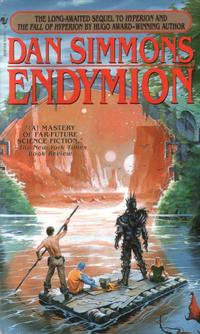 Of the four books in the Hyperion Cantos, Endymion may be the least of the litter. Since Dan Simmons is the author, that still makes for a darn good book.
Of the four books in the Hyperion Cantos, Endymion may be the least of the litter. Since Dan Simmons is the author, that still makes for a darn good book.
Endymion picks up some time after the events of Hyperion and The Fall of Hyperion. In those two books, humanity and AI had forged an alliance allowing humans, via Farcasting, to instantaneously travel and communicate across vast stretches of space. However, the alliance was a sham and the characters of Hyperion brought about the downfall of those technologies and the interplanetary capabilities they supported.
Fast forward two hundred and seventy four years. The known galaxy is in the grip of a resurrected Roman Catholic Church. Humans can literally receive a sacrament of resurrection. Although not without cost, the sacrament is repeatable, and thus real death is mostly unknown in this current age. Farcasting is still busted, but slower than light travel is in use. To put it mildly, Simmons’ Catholic Church is pure evil.
On the planet Hyperion, the old poet Martin Silenus (yes the one from the first book Hyperion) enlists the aid of a young, poor, local hunter, named Raul Endymion. Endymion is to protect the timetraveling child Aenea, daughter of another pair of characters from the Hyperion books. It is Silenus’ vision that Aenea bring about the downfall of the Church, allowing him to write the conclusion of his Cantos. The only aid Silenus provides Endymion is an android assistant and an intelligent spaceship.
The Church however is aware of Aenea’s forthcoming presence and sets out to eliminate her. Thus begins a long chase, the mighty forces of the Church desperately seeking a barely pubescent girl, her somewhat slow, backwater bodyguard, and a blue faux human.
The odds are not in favor of the good guys.
Through Aenea’s power to resuscitate Farcaster portals, Endymion and Aenea lead the hunt across a dizzying array of planets. Simmons has a gift for making each stop a unique tale unto itself. Yet each contributes into an increasingly ugly picture of the horror that the Church is perpetrating. Behind them follows the devout Father-Captain De Soya in a ship that kills its occupants to achieve faster than light transport. Such are the possibilities when resurrection is possible. Yet despite the vast resources of the Church, at every turn De Soya just misses snatching our heroes.
I’ve written earlier about Endymion’s sequel The Rise of Endymion and how excellent it was. Endymion only suffers through comparison to its sibling and its predecessors. The Rise of Endymion has the advantage of the grand climax. Hyperion and The Fall of Hyperion have the benefit of being much more literary, and of course being first. Many of the negative reviews I’ve read are simple dissatisfaction that Endymion is not Hyperion.
But on its own merits Endymion is a really good book. Looking back from a distance, I appreciate the mysteries and conundrums that Simmons set up. The time put into Endymion’s characters makes the final payoff that much more bittersweet. For 2008, Simmons character building is probably the best in any of the books I read. Gaiman may give him a run for the money, but no one else even comes close. Be warned though, if you’re a devout Catholic or other Christian, you may be turned off by his extremely dark vision of organized religion. Other than that caveat I can highly recommend Endymion.
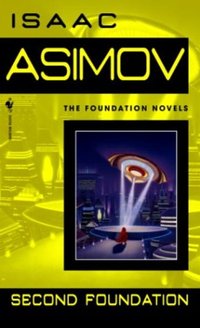 I wish I could claim a rousing finish to the books I read in 2008, but Isaac Asimov’s Second Foundation will have to do. Not that Second Foundation is bad, but the third leg of the Foundation series ain’t exactly cutting edge, fast paced, or deeply moving.
I wish I could claim a rousing finish to the books I read in 2008, but Isaac Asimov’s Second Foundation will have to do. Not that Second Foundation is bad, but the third leg of the Foundation series ain’t exactly cutting edge, fast paced, or deeply moving.
I’ll just use the lame excuse that it was due back at the library right after New Years Day! Can’t afford those exorbitant late fees.
Second Foundation contains two stories. In the first, it is a relatively short time after the events of Foundation and Empire, featuring The Mule, a mutant featuring powers of emotional manipulation and adjustment. The Mule has consolidated his hold on the galaxy and is now obsessed with finding the mythical Second Foundation, the last obstacle to complete domination. He has been able to detect people who have been subtly manipulated in their emotions, signs of a potentially superior psychohistorical force. To suss out the hidden power, he pairs up an older, converted former Foundation rebel, a younger, unconverted overachiever, and points them in the direction of the Second Foundation. Suffice it to say that The Mule gets neutralized and Seldon’s plan is saved once again.
In the wake of these events, the first Foundation has risen again for the second half of the book. However, the Second Foundation has become an almost mystical concept across the galaxy, stalling Hari Seldon’s plan. Meanwhile, a small cadre of Foundationer’s views the Second Foundation as a threat to be rooted out. They hatch a plan to find the elusive organization, but the precocious daughter of Foundation and Empire’s heroine, apparently throws a monkey wrench into the works by stowing away as the plot sets sail.
Similar to the first story, the second half of Second Foundation is a bit of an easter egg hunt. Only at this point in the Foundation series, we’re into our third consecutive tale of “search for the enemy with surprise twist at the end”. Asimov does set up a bit of a conundrum in a “how do you know you’ve defeated the invisible enemy,” vein. Other than the clean tying up of loose ends though, I didn’t find anything really distinctive. In fact, I was somewhat peeved that the world was configured back to mysterious scientists and Seldon’s Plan being well-nigh omnipotent.
You can’t really argue with a classic, but it’ll probably be a while before I read Second Foundation again, if ever.
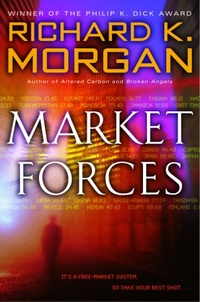 Despite some despicable characters and an uneven plot, Richard K. Morgan’s Market Forces is an entertaining read. In the book notes, Morgan freely admits that the book draws inspiration from Rollerball (I’m assuming the classic James Caan version) and Mad Max. Those elements are combined with a dark vision of executive privilege and immoral capitalism, but not with much actual extrapolated science. This is probably more rightly called speculative fiction than science fiction. Singularity fiends, hard sf geeks, and space opera lovers need not apply.
Despite some despicable characters and an uneven plot, Richard K. Morgan’s Market Forces is an entertaining read. In the book notes, Morgan freely admits that the book draws inspiration from Rollerball (I’m assuming the classic James Caan version) and Mad Max. Those elements are combined with a dark vision of executive privilege and immoral capitalism, but not with much actual extrapolated science. This is probably more rightly called speculative fiction than science fiction. Singularity fiends, hard sf geeks, and space opera lovers need not apply.
The main character, Chris Faulkner, is a fast rising executive in a world where promotion is metered through deadly road rage challenges. Competing executives run each other off the road to get ahead. Faulkner specializes in managing the resources for bloody geopolitical conflict to significant profit. The book starts just as he is joining the high flying London firm Shorn Associates. Think of Shorn as the extrapolation of Blackwater Worldwide. Faulkner has climbed from abject poverty, caused by a global cascading recession (sound familiar), to reach an elite class which is essentially above the law.
Needless to say mayhem ensues.
Market Forces chronicles the internal and external conflicts of Faulkner as he navigates the treacherous waters of becoming a player in Conflict Investment. His management and peers view him as a threat to be roadkilled. His best friend at Shorn is a brutal thug who’s having an affair with the sleazy media whore Faulkner lusts after. Faulkner’s wife thinks he’s becoming a monster. She plots for him to sell out the company even as their marriage falls apart. His ineffectual father-in-law thinks he’s a tool of capitalist excess and tyranny. His clients think he’s just another expensive suited gringo come to colonize their region.
Did I mention that Faulkner occasionally goes psychotic and ruthlessly murders people? As an example he actually brutally beats to death an elderly South American politico. Right in one of Shorn’s expensive meeting rooms!! With a baseball bat!! In front of senior management!! This doesn’t even take into account what happens to the poor lower class scum who get in his way. That’s just the breaks of privilege.
I’ve enjoyed Morgan’s Takeshi Kovacs novels, especially Altered Carbon, but I’d been holding off on Market Forces. Reviews had deemed the book to be somewhat of a dropoff from Morgan’s earlier books, and I have to agree with that sentiment. At 464 trade paperback pages, I think might have been more effective with 100 to 120 less pages. The reduction would have forced Morgan to tighten up a few plot elements, drop a few thin characters, and not linger unnecessarily on some scenes.
Despite all of that, I was oddly compelled to complete Market Forces. This is a credit to Morgan’s plotting ability, born of his screenwriting background. Apparently Market Forces started off as a screenplay, was optioned for film rights, and progressed to a novel. Ultimately, I could find no redeeming features in any of the characters, yet I had to know, “What happens in the end?”.
My final verdict is that unless you really like Morgan, and are a completist, Market Forces is worth a library trip or bumming a copy from a friend. Don’t feel the need to rush out and read it though. It’s got enough interesting elements not to be a complete waste, but I could see folks getting a little peeved after putting down their hard earned money.
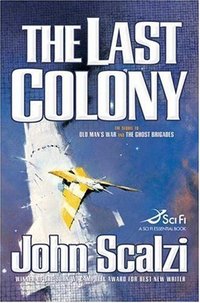 John Scalzi’s The Last Colony is a worthy conclusion to the trilogy that started with Old Man’s War and continued with The Ghost Brigades. Exceedingly jam packed with plot turns and twists, maybe to a fault, Scalzi brings John Perry’s tale to a fittingly circular end.
John Scalzi’s The Last Colony is a worthy conclusion to the trilogy that started with Old Man’s War and continued with The Ghost Brigades. Exceedingly jam packed with plot turns and twists, maybe to a fault, Scalzi brings John Perry’s tale to a fittingly circular end.
Perry has retired from active duty and is now a petty bureaucrat on some backwater planet. Instead of gunning down aliens, he’s now settling disputes over pregnant farm animals. Along with his wife Jane Sagan (retired Special Forces carrying Perry’s ex-wife’s DNA) Perry’s adopted Zoe Boutin, the daughter of the traitorous Charles Boutin from The Ghost Brigades.
The Colonial Union comes calling to this idyllic scene, asking John and Jane to start a new colony, one unusually populated by citizens from a number of existing colonies. The new colony is promoted as a means to pacify agitating colonies, but is also part of a plot to fend off the league of hostile races known as the Conclave. Anymore detail and I could rightfully be accused of spoiling the story.
While The Last Colony is chock full of action, there’s definitely an emphasis on politics and relationships. My only complaint is that I wanted way more of the Consu, the god like alien race from the climax of Old Man’s War. A quick and easy read, in top fashion The Last Colony leaves you wanting more.
Bonus: Since Scalzi is a longtime, prolific blogger, you can catch some of his thoughts right after completing The Last Colony.
Because I’m tired of hassling with full-fledged DBMS systems like MySQL and PostgreSQL for personal stuff, the database behind this blog is sqlite. Data is stored in a simple single file, subject to all the utilities of a typical UNIX environment.
Between a simple db and generating static files with MT, it should be relatively straightforward to use my laptop as a staging server for MPR.
Also makes backups damn easy. A cron job and ssh should do the trick.
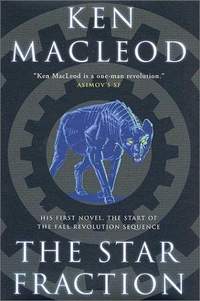 I believe that if I had grown up in Edinburgh, or Europe in general, I would have resonated much more with Ken Macleod’s The Star Fraction. As it is, the book clicked at about the 2/3 mark and turned out to be quite thought provoking.
I believe that if I had grown up in Edinburgh, or Europe in general, I would have resonated much more with Ken Macleod’s The Star Fraction. As it is, the book clicked at about the 2/3 mark and turned out to be quite thought provoking.
The need for a European sensibility comes from Macleod’s approach to politics. As much as The Star Fraction is about hacking computing systems, it’s about hacking political systems. Here in the US we really don’t have a wide diversity of political thought. As our most recent election demonstrated, just an off-hand mention of spreading the wealth can reveal you as a godless, tyrannical, socialist. This makes it a bit tricky to build up empathy with many of the characters as I didn’t have that common ground of political encounters.
The Star Fraction’s protagonist is Moh Kohn, a Trotskyist mercenary who contracts to provide deadly force in the very precisely legislated resolution of conflict. Kohn plies his trade in an ultra-fragmented Europe and specifically the Isle of Britannia. Every stripe of political leaning seems to (un)peacefully coexist in little slivers of the former Kingdom. The good old UN and US are the international bully boys. Meanwhile, man has progressed somewhat into space, where Space Defense can laser fry any serious unrest and workers out of this world are plotting revolutions.
Kohn gets hooked up with Janis Taine, an idealistic scientist on the lam from both ecoradicals and secretive Men-In-Black. The pair is joined by Jordan Brown, an atheist refugee from a fundamentalist Christian enclave. Between the viral AI legacy of Kohn’s father, Taine’s photographic memory inducing drug experiment, and Brown’s encounter with an emergent consciousness an extended chase leads to a phase change for the climax of The Star Fraction.
Despite the lack of political touchpoints, I still managed to connect with Kohn, Taine, Brown, and an assortment of other interesting characters. Macleod also does a fine job of developing the interactions between humanity and emergent AI. I can’t do it justice, but his writing is complex, touching, and evocative in this regard. Once the characters are introduced and the chase really gets going, the plot moves quickly.
If a big helping of overt political thinking on top of your singularity fix sounds intriguing, then The Star Fraction is for you. Recommended.
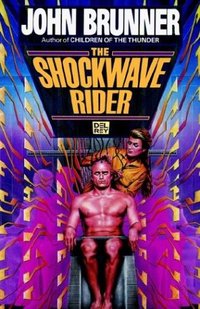 The UK’s Guardian is running a series on 1000 Novels Everyone Must Read. Recently they’ve been listing fantasy, horror, and science fiction that fit in this vein. There’s lots of good suggestions in there. The British angle also broadens the horizon.
The UK’s Guardian is running a series on 1000 Novels Everyone Must Read. Recently they’ve been listing fantasy, horror, and science fiction that fit in this vein. There’s lots of good suggestions in there. The British angle also broadens the horizon.
Obviously, given the breadth of the categories, and the difficulty of clean definitions, there’s a lot of room for argument. I’d definitely add John Brunner’s The Shockwave Rider. If Vernor Vinge’s True Names wasn’t a short story, I’d add that as well. Especially if they’re going to include something like Stephenson’s Snow Crash, which I always felt was overrated a bit due to a reliance on ethnic stereotyping and too much cleverness by half. Hiro Protagonist? Yeesh.
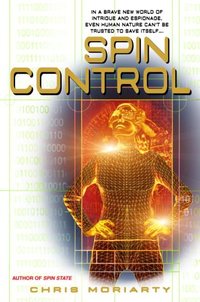 After reading Chris Moriarty’s Spin State, I had low expectations for Spin Control. Truth to tell, if I hadn’t already bought Spin Control with Spin State, I wouldn’t have purchased the former.
After reading Chris Moriarty’s Spin State, I had low expectations for Spin Control. Truth to tell, if I hadn’t already bought Spin Control with Spin State, I wouldn’t have purchased the former.
I was pleasantly surprised by Spin Control though. I’ll get into my dislike for Spin State in a later review, but I can recommend Spin Control.
Spin Control revolves around the defection of Arkady, a Syndicate-born member of a gene line, into the hands of Earth-bound Israeli forces. The Spin series is set well in the future and the Syndicates are essentially post-humans that promulgate through gene splicing and cloning. Particular gene lines are of one sex, with individual deviance hard to discern and indeed proactively stamped out. Moriarty goes to some length to build an analogy with ant species. The Syndicates are generally banned from the UN sphere of influence, including Earth, that comprises the reach of old humanity. Advanced communication and computing technologies, based on quantum computing concepts developed in Spin State, make an appearance as well.
Arkady claims to have a game changing weapon that could swing the outcome of the still ongoing Israeli/Palestinian conflict. In return, he demands the safety of his gene line lover, Arkasha, who has turned out to be a little too distinctive for his line’s tastes. After landing on Earth, Arkady becomes caught up in a complex web of intrigue. Treachery and double crosses abound, across political, cultural, ethnic, and even racial lines. From Spin State, the characters of Catherine Li, herself a genetically amplified human, and Cohen, an advanced, embodied AI, become central players in the game.
A flashback thread spread throughout the book tells the backstory of a colonization voyage that Arkady was a member of as an ant biology scientist. Having being pushed to the periphery of space, the Syndicates are always on the hunt for livable planets. This arc elegantly develops a deeper understanding of Syndicate life and how it is radically different from our existence. The evolution of Arkady and Arkasha’s romance is also captured here.
Setting the tale in The Middle East is a big gambit, and something that could easily fall flat or be in bad taste. Heck, for all I know it could be in bad taste, given that I’m not from the region or invested in the politics. Still, it was an interesting twist. Otherwise, Spin Control reads mostly like a high tech spy novel. Sometimes you need a scorecard to keep track of the players, or more importantly their motivations, but not stupefyingly so.
Emergent systems, individual autonomy, and the definition of human intelligence are the key scientific themes percolating within Spin Control. This was a welcome change from the quantum computing driven Spin State. The fact that I actually have a working introduction to all of those concepts, and didn’t know a jack about quantum computing when I read Spin State, probably had something to do with it. But not needing a physics background to understand the speculative aspect of the story makes Spin Control more accessible.
All in all, Spin Control is a good read, putting questions of individuality and autonomy into the context of a familiar centuries old conflict, played out as a techno thriller.
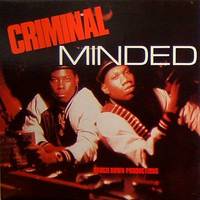 Amazon gave me $8 of promotional credit in the Amazon MP3 Store thanks to some other Christmas gift purchases. I needed to use it before January 31st so started casting about for things of interest.
Amazon gave me $8 of promotional credit in the Amazon MP3 Store thanks to some other Christmas gift purchases. I needed to use it before January 31st so started casting about for things of interest.
DJ mix house music is still a tough get. Not to mention that Amazon often sells dj mixes as one big mp3, not separating the tracks. However, the other two major services, iTunes Music Store and eMusic, have this bad habit as well, so I can’t ding them too hard for this.
Going back to my hip-hop roots, I finally settled on Boogie Down Productions Criminal Minded. But heresy of heresy, you can’t buy Public Enemy’s It Takes A Nation of Millions to Hold Us Back. A quick peek in the iTMS reveals they have it “in stock”.
iTMS 1, AzMP3 0
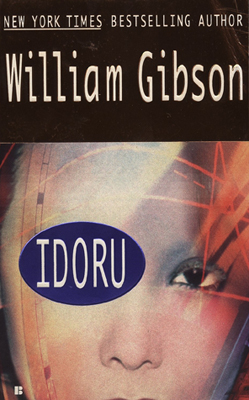 Playing Hearts cut into my blog writing time. Now that I’ve slaked my thirst a bit, let’s see if I can get back on track.
Playing Hearts cut into my blog writing time. Now that I’ve slaked my thirst a bit, let’s see if I can get back on track.
Idoru is the classic second of a trilogy book. The individual story is fairly fulfilling on its own, the overall plot is advanced, but since there’s a third chapter coming the second can’t give you ultimate satisfaction.
That said, Idoru may be the most coherent of Gibson’s Bridge Series. Virtual Light, which didn’t fall into the 2008 books read list, involves a lot of introductions, which gives it a slow start. All Tomorrow’s Parties layers on new characters and plot creating a frantic rush at the end. Idoru may be just right.
Idoru’s tale is typical Gibson interweaving multi-arcs, jaunting across the Pacific Rim, from Seattle to Japan. One protagonist, Colin Laney has a specific talent for data sifting. He sees “nodal points”, sort of intuitive connections of data flows and cultural happenings. The other main character, Chia, is a fangirl of the band Lo/Rez. The threads of Laney and Chia barrel towards each other as Laney is hired into Lo/Rez’s service and Chia journeys to Tokyo to find out the truth about recent band rumors. Meanwhile, Rez is bent on marrying Rei Toei, a Japanese pop-idol who just happens to be completely virtual.
A decade later, Idoru seems somewhat prescient. I read the novel as speaking on a forthcoming intersection of technology, celebrity, and fandom. Gibson was clearly extrapolating from trends in Japan, but I think we’ve seen some of the themes play out here in the United States. A young teen American girl whimsically picking up, making a trans-Pacific journey, and finding succor through pop culture fan clubs is not out of the realm of possibility. Bands who are more self-sustaining corporate entities then artistic endeavors are here. Plus they’re popularity is increasingly intermeshed with the tides of The Web. And we seem to be slouching towards purely virtual entertainers.
But to make it short and sweet, it had been a long time since I’d read Idoru. It was much better than I remembered.
It’s official. Barack Obama is the 44th President of the United States of America.
Being an optimistic 40ish, I thought this would happen in my lifetime. Didn’t think it would come this soon or this way. I’m finding as I get grayer though, that greatness, and great moments, often arrive earlier than one expects.
—William Gibson
 I sprung for a copy of Freeverse’s game 3D Hearts.
I sprung for a copy of Freeverse’s game 3D Hearts.
That might have been a mistake. Talk about a big time sink.
I can’t say I’m particularly blown away, but it’s a nicely polished product. You can play against a handful of odd characters each with uniquely humorous dialog. Then again there’s not a whole lot you can do with the game of Hearts.
It’s about the best version of Hearts I found for the Mac, given a limited web search. There’s probably a comparable free version, but for $20 I didn’t have to think too hard.
I’ve always admired John Watson’s ever growing menagerie of Flickr hacks. Having recently revisited the site, I enjoyed his overview of what happens over time to one day page of Flickr’s Explore. A given day page is not frozen in time for Explore’s purposes. The only thing that’s fixed is the population that can appear on that day page: photos shot on that day. Otherwise, only the Flickr boffins know what determines which photos are displayed at any given moment.
Once upon a time I used to be really interested in Flickr’s interestingness algorithm. I was also curious about the statistics and properties of the photos that did have high interestingness. The Flickr API has to be one of the nicer web service api’s out there and there was a nice Python library to access the service. I implemented some code for decent sized longitudinal studies similar to Watson’s captures.
Looking at the video Watson created, the thought came to me that there’s actually a lot more potential for using those interesting photos as a gateway into Flickr. As his automatically built movie demonstrates, one can easily build new media artifacts with those photos as a seed. Attached to each of those photos is a Flickr user, an entry point into the Flickr social network. I’m going to start Flickr hacking again to see what I can come up with.
 Meanwhile, also on the open data front, CiteULike makes data dumps available. CiteULike is a social bibliography service aimed at academic researchers. The service provides tagging ala del.icio.us, but is more vertical in that it understands URL references into many journal publishing services. CiteULike also provides hooks to upload common bibliography formats or download your bookmarks into common bibliography tools.
Meanwhile, also on the open data front, CiteULike makes data dumps available. CiteULike is a social bibliography service aimed at academic researchers. The service provides tagging ala del.icio.us, but is more vertical in that it understands URL references into many journal publishing services. CiteULike also provides hooks to upload common bibliography formats or download your bookmarks into common bibliography tools.
The CiteULike data dumps capture posting activity, linkouts (resolution of internal ids to actual articles), and group membership. This might be an interesting “starter” dataset for folks looking to practice application of network analysis algorithms, information retrieval techniques, or information visualization.
Discogs.com has an API. The interface is small, lightweight, and RESTful. There are 4 methods: get release, get artist, get label, and search. They rate limit requests to 5000 in 24 hours, which is generous. Even better, each response tells you how many requests you’ve used.
Best of all, data retrieved is in the Public Domain. Do with it what you will.
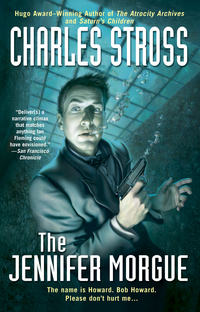 Charlie Stross that is.
Charlie Stross that is.
One of the nice things about getting back into reading books is that many authors now blog. I’m monitoring a rather arbitrarily compiled “4 Horsemen of the Scifiblogalypse”: Charles Stross, John Scalzi, Neil Gaiman, and Cory Doctorow.
In The Atrocity Archives, Stross had a lengthy addendum describing how the book was a combination of spy thriller and Lovecraftian horror. Apparently he’s working on some follow up novels and the process is … nibbling at the dark corners of his mind. He coins the term Strangelovecraftian to cover the style of horror he’ll be further exploring in the Laundry series. Looks like it’ll be a blend of the absurdity of Kubrick’s Dr. Strangelove and Lovecraft’s apocalyptic shuffling things from a cold, dark, alien time. It’ll probably be quite funny, in a sick sort of way.
Anyway, it’s an interesting look at how an author thinks about shaping an upcoming work. Now I have to go and place an order for the trade paperback of The Jennifer Morgue.
I work smack in the middle of the DC Metro area, typically ensconced in a lovely office building in the Ballston section of Arlington, VA. I live at the margins of “DC”, way out in Loudoun County, VA, not too far from the West “By God” Virginia border. Don’t ask.
Despite growing up 20 years ago in Frederick County, MD, and moving back to DC about 2 years ago, I’m still not into the tempo of the city.
DC Blogs is helping to fix that. I’m enjoying the DC Blogs Noted feed, which serves reasonable tapas-style portions of DC themed blogs on a daily basis. The editors have a fine sensibility and the blurb writing that goes along with each linked post is exquisite. They also have an aggregator, DC Blogs Live, which looks like it might be a bit of a firehose. Not quite ready to jump into that yet.
In any event, good on ya DC Blogs.
 Okay I know it’s a beta, but Google Blog Search has some serious wackness. Here’s their post history for Mass Programming Resistance. There’s a whole week of January missing.
Okay I know it’s a beta, but Google Blog Search has some serious wackness. Here’s their post history for Mass Programming Resistance. There’s a whole week of January missing.
What’s wack is that the main Google search engine actually has said missing posts indexed. Not to mention Google Reader. Frankly both of the sibling properties of Google Blog Search are scary in how fast they visit after I post.
WTF?! Sibling rivalry?
My suspicion is that there might have been some ping wonkiness, as I remember a couple of entries leading to duplicate posts that may have made me look like a spammer. But I’m not going to put a lot of effort into figuring this one out. Got better things to do.
I was probably at my physically fittest in September 2001. Someday I may tell a long 9/11 story that will explain how I know this. Don’t worry it’s low drama with a happy ending. In the meantime, it has been a long slow decline to sitting on my ass all day and being a good 20 - 30 lbs over my ideal BMI. I’m putting it in pixels here just so the goal can stare me coldly, laughingly in the face.
In the first quarter of the year I’d just be happy to have the exercise ball rolling in a consistent fashion. 3 times a week of 30 - 60 minutes of serious workout and I’ll declare victory on that front. I figure after that the habit will have stuck.
By the end of the year, down 20 lbs, although I have higher hopes than that. I’ve already started tweaking the diet and seeing some small gains. Got to make them stick though.
Charlie Jane Anders may have to post a bunch of insipid crap at io9 to pay the bills, but she can write some damn fine and worthwhile reviews in addition to meaty interviews.
 LaunchBar is another MacOS application which I pay for. In fact, I bought a Titanium G4 MacBook just after the turn of the century and I had purchased LaunchBar for that machine.
LaunchBar is another MacOS application which I pay for. In fact, I bought a Titanium G4 MacBook just after the turn of the century and I had purchased LaunchBar for that machine.
Despite shelling out the dollars, I’ve never actually exploited LaunchBar to its fullest. Oh sure, Command-Space is committed to muscle memory, but I basically use the tool like a smart application launcher.
Last night I tried using it to play an album I had ripped to iTunes so I didn’t have to switch to iTunes. It sort of worked, adding the album tracks to a new “Launcbar” playlist, improperly ordered, and hitting play on iTunes. Then I figured out I needed to pick the playlist I wanted in LaunchBar and It Just Worked!
Brilliant! I figure it’s only really good for favorite playlists and not digging through to find one’s you haven’t listened to recently. Then again that’s the whole point, to save you effort on the stuff you do (listen to) frequently.
Today I was trying to LaunchBar into the URL for Google Image Search. Turns out LaunchBar already has a little widget you can hot key to, enter your query, and pull up the page with your search results. Suhweet!
Might be time to check out that manual. And I will definitely be forking over the dough to upgrade once LaunchBar 5 goes final.
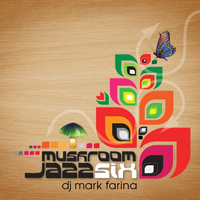 As predicted, Mushroom Jazz 6 is growing on me. My current thought is that the first 2/3 to 3/4 is bumpin’ but the tail end still doesn’t grab me. It’ll probably take a few more weeks of listening to converge though.
As predicted, Mushroom Jazz 6 is growing on me. My current thought is that the first 2/3 to 3/4 is bumpin’ but the tail end still doesn’t grab me. It’ll probably take a few more weeks of listening to converge though.
However the three track run of:
is definitely sicktastic!
 Film at 11. Image cribbed from the in depth analysis from Wired Epicenter by Elliot Van Buskirk. And just when I was about to seriously start considering Amazon’s MP3 Downloads.
Film at 11. Image cribbed from the in depth analysis from Wired Epicenter by Elliot Van Buskirk. And just when I was about to seriously start considering Amazon’s MP3 Downloads.
Looks like there might be some blog mileage in digging into each service’s dj mix catalog and seeing what I find.
![]() For whatever reason, I don’t see much link love for Discogs.com in the circles I travel. It’s a great open source effort to capture artist discographies and album listings in obsessive, gory detail.
For whatever reason, I don’t see much link love for Discogs.com in the circles I travel. It’s a great open source effort to capture artist discographies and album listings in obsessive, gory detail.
Discogs.com actually solved a decade old mystery for me. Living in the SF Bay Area in ‘94, and partaking heavily of the underground house music scene, I moved into the modern era and started buying dj mix cds. One of the earliest, maybe even the first, was Little Louie Vega’s United DJs of America, V2: New York City. I wore that thing out and still enjoy listening to it 14 years after its release. The build and release at the end is to die for.
However, Track 16, listed as In The Dark We Live by Aphrohead, always puzzled me. I was familiar with all of the vinyl releases of that cut and knew that on Vega’s mix there was something else blended in that carried really distinctive vocals. “I dance … and I sweat … and I let myself… Go!” I searched high and low. I even got someone on Usenet to promise to unearth the secret. They never came through, go figure. I gave up the chase until I found Discogs.com
 Digging around under Vega’s discography I checked the DMC UK version of United DJs V2. Sure enough, “Notes: Sleeve mistakenly shows track 16 as Aphrohead - In The Dark We Live.” Instead it was Head Rush’s Underground and apparently the only track they ever released. Talk about obscure!
Digging around under Vega’s discography I checked the DMC UK version of United DJs V2. Sure enough, “Notes: Sleeve mistakenly shows track 16 as Aphrohead - In The Dark We Live.” Instead it was Head Rush’s Underground and apparently the only track they ever released. Talk about obscure!
Technically the track listing is correct, but it would have also been fair to credit Head Rush in the liner notes as well. In a similar fashion, Vega cribs from himself and The Bomb (These Sounds Fall Into My Mind) makes an uncredited appearance early in the mix. Maybe it had something to do with licensing.
The Web provides.
Scott Rosenberg beat me to it but I meant to point to an interesting New Yorker article drawing parallels between The Village Voice and The Blogosphere. I’m in agreement with Rosenberg that the spirit of the early Voice was akin to blogging’s ethos, but that The Voice was nowhere near what the blogosphere is now. As a fan of early hip-hop, I hear echoes of the whole “Lou Reed rapped, so he was the father of hip-hop” line of argument. Yeah, right.
The correct phrasing is that The Village Voice presaged the blogosphere.
I used to have a somewhat curmudgeonly view of gift cards. A gift card was saying, “I don’t care enough to bother shopping for you, but care just enough to tell you where to spend my money!” I took a slightly less dim view of cash. At least you can spend that anywhere on anything or even stash it and earn compound interest. My overarching principle though is that if you really want to give a gift, put in the freaking time to consider and select one.
Of course my mother-in-law had to go and wreck that philosophy.
Now I should mention that the fact that these cards were quite generous was a factor. My mother-in-law was definitely not into the $10 Starbucks drive-by. I’ll just say that while you couldn’t get a laptop or netbook, much of the iPod line was in range. Still, if one was truly being a humbug, the above sentiment would apply no matter the denomination.
But the key was that the past few gift cards (8 or so between Christmas and birthdays) were from Borders. Big deal you say? Well up until this year, Borders.com was essentially a private label Amazon.com for books and music. Win!! At least until Borders decided to strike out on their own. One highly inconvenient Borders shopping trip with a gift card later (Whaddya mean my Amazon Prime doesn’t apply? How the hell do you find the House music in this mess?) and I’m dropping hints with my wife that it would be great if she could find a way for her Internet challenged mom to generate Amazon gift cards.
This Christmas we made a step forward to the BestBuy gift card, as generous as ever. Granted it’s not as convenient as Amazon or price competitive as NewEgg, but I look at it this way. A decent sized gift card is a pretty good head start on a significant electronic purchase. That’s how the MacBook purchase came about. I had a store credit and didn’t really know what to do with it. That plus saving some pennies over time got me a new laptop. Same concept will apply with my mother-in-law’s present. I’m thinking of targeting a digital SLR camera.
My mother-in-law will never shop for the geek stuff I like. But she never wants to be told what to get for a gift. A stance I agree with. Gift demands are for children. Judiciously chosen gift cards allow us to meet halfway.
Subsequently, I’ve revised my thinking about gift cards. Obviously, I’m going to graciously receive them. But now I’ll consider giving them, although I try to team them up with something inexpensive that I’ve picked out, just to show I’ve put in the effort.
Furious downloading shall commence as soon as this is posted.
Also: A nice overview of the Picasa Mac Beta from Michael Calore at Wired’s Epicenter blog.
Wish me luck. I’m going to try and upgrade to Movable Type 4.23 in-place. Breakage may ensue.
Update: Looks like we have success.
 One of the side benefits of the book reading effort of 2008 was the discovery of the Arlington County Public Library, which is a few blocks away from where I work. Besides a nice collection of books they have reliable, no registration, WI-FI, and plenty of computer friendly tables. They’ll even send you e-mail notices about upcoming due dates. I’ve taken to dropping in over lunch or when there’s some slack time between knocking off work and catching my bus home.
One of the side benefits of the book reading effort of 2008 was the discovery of the Arlington County Public Library, which is a few blocks away from where I work. Besides a nice collection of books they have reliable, no registration, WI-FI, and plenty of computer friendly tables. They’ll even send you e-mail notices about upcoming due dates. I’ve taken to dropping in over lunch or when there’s some slack time between knocking off work and catching my bus home.
Browsing the graphic novel section, I came across the collected versions of Frank Miller’s Sin City comics. Although I didn’t think the movie was great (the intense ultraviolence can be offputting) I thought The Hard Goodbye was excellent and in hindsight portends Mickey Rourke’s star turn in The Wrestler. The voiceovers in The Big Fat Kill and That Yellow Bastard were overly intrusive. However, the movie worked for me visually as an audacious attempt to bring a comic book to life on the big screen.
I didn’t realize the extent the movie was an almost literal interpretation of the comics. I had repeatedly watched Sin City on cable in 2007 long before I got my hands the graphic novels. I would say 90 percent of the plot survived directly from the books. Probably 75 to 80 percent of the dialog was retained, which I find pretty remarkable. Having gone back to the original source material, I have to commend Robert Rodriguez et. al. for creating a pretty compelling experience that’s true to the original vision and style. Obviously having Frank Miller on the team helped, but it’s still a pretty far leap from the comic form to cinema. That’s why they’re different media.
 While Old Man’s War was a revelation, The Ghost Brigades is a worthy successor. Originally I thought The Ghost Brigades fell a little short of Old Man’s War, but upon some reflection I think it might be just as good if not better.
While Old Man’s War was a revelation, The Ghost Brigades is a worthy successor. Originally I thought The Ghost Brigades fell a little short of Old Man’s War, but upon some reflection I think it might be just as good if not better.
The Ghost Brigades continues in John Scalzi’s world of the Colonial Defense Forces protecting spacefaring colonists from an exceedingly hostile galaxy. The sequel moves into a deeper exploration of the CDF’s Special Forces, a.ka. The Ghost Brigades, radically augmented humans bred from the womb to take on the really dirty tasks of space warfare. Members of the Ghost Brigades are synthesized from gene lines harvested from CDF volunteers who die before getting their new bodies. They’re old, it happens. Because of this, and the augmented capabilities they receive, Special Forces are considered to be a bit freakish.
The protagonist, Jared Dirac, is an odd case even amongst this band of post-humans. Through a confluence of highly damaging treason against the Colonial Union and “consciousness transfer” technology, Jared is technically a clone of a high profile traitor, Charles Boutin. However, failing to initially reveal any knowledge that could lead to the capture Boutin, Jared is simply entered into the Special Forces. This gives Scalzi, in homage to Heinlein, room to explore how troops train, adapt to their technology, and ultimately bond. Eventually Jared enters into his tour of duty, sees a couple of harrowing missions and ultimately becomes key in a high risk plot to eliminate Boutin.
Where The Ghost Brigades diverges somewhat from Old Man’s War is a clearer emphasis on some of the ethical, political, and philosophical conundrums hinted at in Old Man’s War. For example, the odd status of the Special Forces as post-humans definitely comes to the fore. While Old Man’s War was a good end-to-end tale, the originality of its fundamental premise, the wisdom of old age fused into engineered warfaring youth, is the critical hook. That trick can’t be relied on in The Ghost Brigades, but the reward is deeper exploration of what it says about humanity to take old people and recycle them into soldiers, to create post-human super soldiers who haven’t experienced adolescence before seeing battle, and to willy-nilly record and transfer consciousness between physical bodies. Not to mention various devious tactics employed by a number of the main characters.
So while I’m sure there are plenty of folks who think The Ghost Brigades, by virtue of being a sequel, can’t stand up to Old Man’s War, I actually think it does quite well.
© 2008-2025 C. Ross Jam.
Licensed under CC
BY-NC-SA
4.0 Built using Pelican. Theme based upon Giulio
Fidente’s original svbhack,
and slightly
modified
by crossjam.